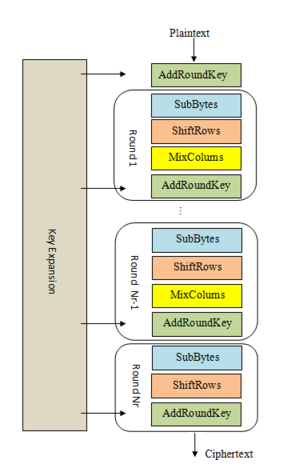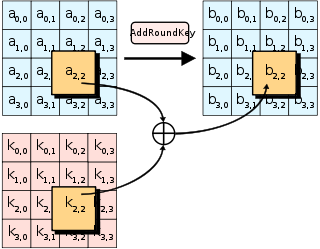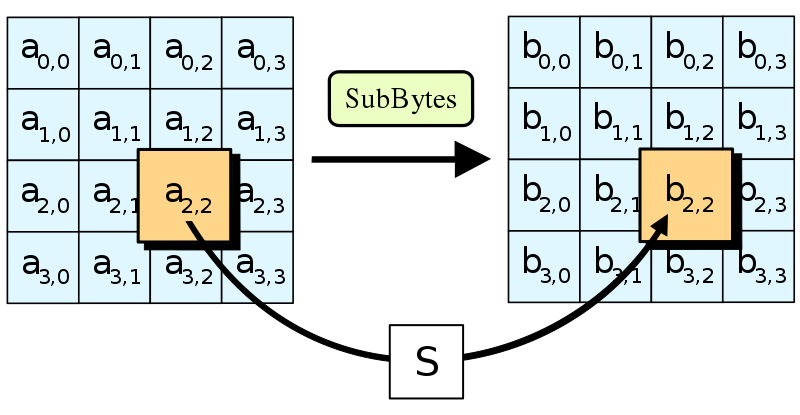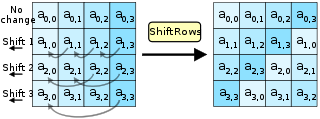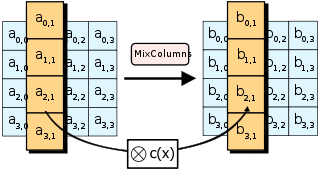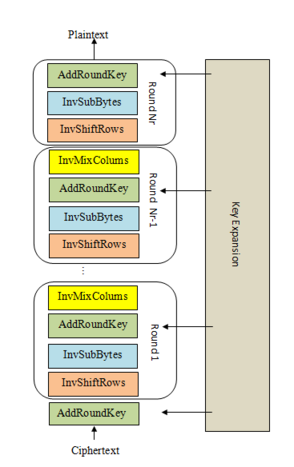I. How AES works
1. Keyed Permutations
Description (Translated)
- AES, tương tự như các loại mã hóa khối mạnh khác, đều thực hiện việc hoán vị khóa (keyed permutation).
:bulb:
Một block hay một khối trong mã hóa khối chính là một lượng cố định bits hay bytes của dữ liệu. AES nhận một khối làm input và mã hóa thành một khối khác trả ra output. CryptoHack sẽ cung cấp thông tin chính về loại mã hóa AES trên khối 128 bit (16 byte) và khóa 128 bit, hay được biết tới với tên gọi AES-128
- Sử dụng cùng một khóa, ta có thể thực hiện việc khôi phục lại bản rõ bằng cách sử dụng hoán vị ngược (inverse permutation). Điều này đặc biệt quan trọng bởi khóa chính là cầu nối (ánh xạ) giữa bản rõ và bản mã trong hệ mật đối xứng như AES, nếu không có khóa, việc giải mã sẽ rất khó khăn, gần như là không thể. Ánh xạ (Bijection) trong đại số là phép liên kết tương ứng mỗi phần tử x với một và chỉ một phần tử y của hai tập hợp.
- Câu hỏi: Thuật ngữ toán học nào có nghĩa là one-to-one correspondence.
Flag
crypto{bijection}
2. Resisting Bruteforce
Description (Translated)
- Với một mã khối đủ mạnh, một attacker sẽ không thể phân biệt bản mã của AES với một chuỗi bit được hoán vị ngẫu nhiên. Vì vậy, không có cách nào đơn giản hơn tấn công vét cạn tất cả các khóa có thể.
:bulb:
Xét việc tấn công vét cạn một khóa 128 bit của AES, có ước tính cho rằng sẽ mất tới hàng nghìn năm tuổi vũ trụ để phá khóa.
- Có một cách tấn công AES mạnh hơn vét cạn, trên thực tế nó chỉ làm giảm độ bảo mật của AES-128 xuống còn 126.1 bits. Đó chính là Biclique attack, là single-key attack tốt nhất từng được công bố nhưng không phải là một đe dọa quá lớn tới AES.
- Bên cạnh đó, máy tính lượng tử mặc dù có tiềm năng to lớn trong việc phá vỡ những hệ khóa công khai như RSA bằng Shor's algorithm, nó vẫn tương đối yếu khi chỉ có khả năng làm giảm độ bảo mật của AES xuống còn phân nửa bằng Grover's algorithm. Vì vậy người ta ưa dùng AES-256 hơn, dù khó để cài đặt hơn, bởi khả năng bảo mật mạnh mẽ trước máy tính lượng tử trong tương lai.
- Câu hỏi: Đâu là phương thức single-key attack on AES tốt nhất.
Flag
crypto{biclique}
3. Structure of AES
Description (Translated)
- Để tạo ra một khóa hoán vị đủ mạnh, AES kết hợp thực hiện nhiều phép biến đổi trên input. Đây là điểm tương phản với phương pháp của hệ mật RSA sử dụng những phép toán tinh tế, AES nhanh gọn và đơn giản hơn.
- AES-128 bắt đầu với một quy trình chính (key schedule) và thực hiện 10 vòng mỗi state. Ở đây, state khởi tạo chính là khối bản rõ được viết dưới dạng ma trận 4x4 bytes (
4*4*8 = 128 bits).Trong mỗi 10 vòng, state sẽ được biến đổi bằng những thuật toán không thể đảo ngược.
:bulb:
Mỗi lần biến đổi đều tuân theo lý thuyết của Claude Shannon.
- Dưới đây là tổng quan các giai đoạn mã hóa AES:
1. Mở rộng khóa: Từ khóa 128 bit, 11 khóa vòng 128 bit khác nhau được khởi tạo để sử dụng cho bước sau.
2. Khởi tạo khóa: AddRoundKey: mỗi bytes của vòng đầu tiên sẽ được xor với bytes của state.
3. Thuật toán: Thuật toán được lặp lại 10 lần, 9 lần lặp chính và một lần lặp cuối cùng gọi là final round:
a. SubBytes: mỗi bytes của state được thay thês bằng một bytes khác bằng cách đối chiếu với S-box.
b. ShiftRows: mỗi 3 hàng ma trận của state sẽ được chuyển vị trên một, hai hoặc ba cột.
c. MixColumns: thực hiện phép nhân ma trận trên các cột của state, kết hợp với 4 bytes ở mỗi cột. MixColumns chỉ được thực hiện trên 9 vòng lặp đầu tiên.
d. AddRoundKey: mỗi bytes của vòng đầu tiên sẽ được xor với bytes của trạng thái.
- Câu hỏi: Ta có hàm
bytes2matrixgiúp chuyển bản rõ dạng khối ban đầu thành một ma trận trạng thái. Viết hàmmatrix2bytesđể khôi phục lại bản rõ (chính là flag của bài) - Challenge code:
Solution
- Code:
Flag
crypto{inmatrix}
Note
- Thay vì code dài dòng như trên, ta có thể sử dụng hàm bytes và sum như sau:
4. Round Keys
Description (Translated)
- Sau bước khởi tạo khóa ở trên, AddRoundKey được thực hiện, nó xor state hiện tại với khóa vòng tương ứng.
- AddRoundKey cũng được thực hiện ở cuối mỗi vòng. AddRoundKey cũng chính là giai đoạn duy nhất của AES mà khóa được trộn với state, tạo thành sự hoán vị khóa đặc biệt.
- Câu hỏi: viết hàm
add_round_keyvà sử dụng hàmmatrix2bytesđể khôi phục lại flag. - Challenge code:
Solution
- Code:
Flag
crypto{r0undk3y}
Note
- Thực ra ta có thể viết hàm
add_round_keybằng chỉ một dòng như sau:
5. Confusion through Substitution
Description (Translated)
- Bước đầu tiên của mỗi vòng AES là SubBytes. Ta lấy mỗi bytes của ma trận state và thay thế chúng với một byte khác trong bảng tra 16x16 gọi là S-box.
- Từ "confusion" bắt nguồn từ lý thuyết của nhà toán học Claude Shannon năm 1945, đề cập tới mối liên hệ giữa bản mã và khóa nên được phức tạp hóa hết mức có thể. Sao cho khi chỉ có bản mã, không một ai có thể biết điều gì về khóa. Nếu một mật mã có "confusion" yếu, nó sẽ dễ bị phá vỡ hơn.
- Mục đích chính của việc xây dụng S-box là để tạo ra bản mã khó bị phân tích bởi các hàm tuyến tính.
- Câu hỏi: viết hàm
sub_bytesvà truyền dữ liệu một ma trận state qua một S-box đảo ngược và khôi phục flag. - Challenge code:
Solution
- Ta chỉ cần truyền ma trận state vào inv_s_box là xong.
- Code:
Flag
crypto{l1n34rly}
6. Diffusion through Permutation
Description (Translated)
- Ta đã thấy được cách mà S-box tạo ra tính "confusion" cho AES. Một tính chất khác mà trong lý thuyết của Shannon cũng được đề cập là "diffusion", nghĩa là cách mà bản rõ khuếch tán đến bản mã.
- Bản thân việc SubBytes các bytes đã tạo ra sự phi tuyến tính cho hệ mật AES, tuy nhiên nó không phân phối trên toàn state. Nếu không có "diffusion", các bytes giống nhau ở cùng một vị trí sẽ có cách SubBytes y hệt nhau, điều này làm giảm tính bảo mật của AES bởi attacker có thể tấn công từng bytes riêng lẻ trong ma trận state. Chính vì vậy, ta cần xáo trộn ma trận trạng thái (tất nhiên là có thể khôi phục lại). Mỗi đầu vào của S-box kế tiếp sẽ trở thành hàm của rất nhiều bytes khác nhau, làm tăng đáng kể tính phức tạp của AES.
:bulb:
Một "diffusion" lí tưởng có thể khiến sự thay đổi một bit trong bản rõ làm ảnh hưởng tới nửa số bits của bản mã. Đây chính là Avalanche effect.
- Bước ShiftRows và MixColumns kết hợp với nhau để tạo ra "diffusion" này, đảm bảo rằng mỗi byte sẽ ảnh hưởng tới các bytes khác trong state chỉ với 2 vòng tạo mã.
- ShiftRows là cách biến đổi đơn giản nhất trong AES. Cách thực hiện có thể thấy qua hình sau:
- MixColumns phức tạp hơn bởi nó thực hiện việc nhân ma trận giữa cột của ma trận state và một ma trận cho trước trong trường Galois. Vì thế mỗi bytes của cột ảnh hưởng tới toàn bộ bytes trong cột kết quả. Tham khảo tại đây, wikipedia này và hình sau:
- Câu hỏi: Cho biết code để thực hiện MixColumns và ShiftRows, khôi phục flag.
- Challenge code:
Solution
- Nhìn vào hàm
shift_rowskhá đơn giản ở kia, ta có thể viết hàminv_shift_rowsnhư sau (nên kiểm tra lại):
- Sau đó sử dụng
mix_columnsrồiinv_shift_rows, ta có được flag:
Flag
crypto{d1ffUs3R}
Note
- Có một cách viết hàm
inv_shift_rowsngắn hơn, đó chính là thực hiệnshift rows3 lần. Ma trận có dạng 4x4 nên nếu dịch chuyển đủ 4 lần, ma trận sẽ được khôi phục lại như ban đầu. Vì vậy ta viết như sau:
7. Bringing It All Together
Description
- Challenge code:
Solution
- Dựa theo gợi ý của bài, ta sẽ thực hiện việc giải mã theo chiều mũi tên:
- Code (hơi dài nên thay vì viết từng hàm ra ta có thể sử dụng code từ những bài trên bằng syntax
from ... import):
Flag:
crypto{MYAES128}
Note:
- Giải xong bài thấy buồn thiu vì bài này hay vãi nho :crying_cat_face:
II. SYMMETRIC STARTER
8. Modes of Operation Starter
Description (Translated)
- Phần I đã giới thiệu chi tiết về việc hoán vị khóa của AES. Trên thực tế, ta cần mã hóa tin nhắn dài hơn một khối. Chính vì vậy, các "mode of operation" ra đời để thực hiện việc mã hóa AES trên một tin nhắn dài.
- Tất cả các modes đều có những nhược điểm nhất định khi không được cài đặt đúng cách. Challenge của bài giới thiệu một website để tương tác với APIs và khai thác một vài lỗ hổng trong mode ECB.
- Challenge code:
Solution
- Ta chỉ cần đưa
ciphertextởEncrypt_Flagvào hàmdecryptcó sẵn để nhận đượcplaintext. Đem đi dịch qua hex ta nhận được flag. Với bài này, ta không cần biếtkeyđể giải mã vìkeyđược tái sử dụng trong chính hàmdecryptrồi. - Code:
Flag
crypto{bl0ck_c1ph3r5_4r3_f457_!}
9. Passwords as Keys
Description (Translated)
- Trong AES, hiển nhiên khóa là một chuỗi các bytes ngẫu nhiên thay vì mật khẩu hay những loại dữ liệu dễ đoán khác. Khóa có thể được tạo ra bằng CSPRNG (hay cryptographically-secure pseudorandom number generator).
- Khóa trông giống một chuỗi bytes ngẫu nhiên, tuy nhiên không nhất thiết phải như vậy. Trong trường hợp này khóa được tạo ra từ mật khẩu đơn giản sử dụng hàm băm.
- Website để tìm flag
- Challenge code:
Solution
- Hướng đi của bài là brute-force, key là bluebell sau khi chạy xong vòng lặp.
- Code:
Flag
crypto{k3y5__r__n07__p455w0rdz?}
Note
- Đừng gửi brute force từng key lên web nếu không muốn nổ máy :warning:
III. BLOCK CIPHERS
10. ECB CBC WTF
Description
- Here you can encrypt in CBC but only decrypt in ECB. That shouldn't be a weakness because they're different modes… right?
- Play here
- Challenge code:
Solution
- Mode CBC:
- Đầu tiên, ta lấy giá trị của
ciphertext. Trước tiên ta cần chuyểnciphertextthành dạng bytes. Nhận thấyciphertextcó độ dài 48, trong đóivlà 16 kí tự đầu nên ta sẽ chia đoạn bản mã sau thành haiblock1vàblock2. - Ý tưởng giải mã khá đơn giản nếu nhìn vào sơ đồ giải mã CBC ở trên. Với
ivta đã có, bên cạnh đó web còn cung cấp một hàm giải mã bằng ECB (hàm này giúp ta bypass việc thiếukey). Code của chúng ta sẽ như sau (code làm gián tiếp chứ không tương tác trực tiếp với web):
Flag
crypto{3cb_5uck5_4v01d_17_!!!}
Note
- Một bài khá hay giúp hiểu rõ hơn về hai mode được sử dụng nhiều là ECB và CBC. Bên cạnh đó ta có code để tương tác trực tiếp với web như sau:
11. ECB Oracle
Description
- ECB is the most simple mode, with each plaintext block encrypted entirely independently. In this case, your input is prepended to the secret flag and encrypted and that's it. We don't even provide a decrypt function. Perhaps you don't need a padding oracle when you have an "ECB oracle"?
- Play here
- Challenge code:
Solution
- Trước tiên ta cần hiểu được cơ chế padding của code trên. Code sẽ tự động đệm thêm các bytes để độ dài block là một bội của 16, tại đây ta có thể xác định được độ dài của flag. Code như sau:
- Chạy một code đơn giản như trên, ta nhận thấy với giá trị
i = 6thìlen(get) = 32,i = 7thìlen(get) = 48. Chính vì vậy,len(FLAG)thỏa mãn7 + len(FLAG) = 32nênlen(FLAG) = 25. Cũng khá may mắn khi mode được chọn là ECB nên công việc đơn giản hơn rất nhiều. Bên cạnh đó ta có thể sử dụnglen(FLAG)để assert sau. - Trước khi đi vào giải bài toán, ta cần biết sơ đồ của ECB:
- Ta sẽ giải bài toán theo thuật toán này. Vì brute force khá lâu nên ta không chọn
FLAG = ''mà làFLAG = 'crypto{'. - Code:
Flag
crypto{p3n6u1n5_h473_3cb}
Note
- Đây là một bài khá hay cũng tựa tựa Padding Oracle Attack on CBC. Bạn mình trước cũng làm bài này nhưng đọc từ đuôi flag trở về đầu mà đến bây giờ mình vẫn không hiểu sao làm được thế :smile_cat:.
- Lấy chars trong khoảng trên cho dễ, cũng may FLAG không troll bằng mấy kí tự quần què khác :sweat_smile:.
12. Flipping Cookie
Description
- You can get a cookie for my website, but it won't help you read the flag… I think.
- Play here
- Challenge code:
Solution
- Tham khảo tại link
- Chúng ta sẽ quan sát hàm
get_cookie()trước. Hàm dùng để mã hóacookiesau khi pad, với giá trị củaivgắn ở đầu. Ta có thể lấy giá trịcookiedễ dàng. - Ta đã biết được mode CBC chia bản rõ thành các khối 16 bytes, vậy thì ở đây ta có khối đầu tiên là:
block = admin=False;expi,… Quan sát tiếp hàmcheck_admin, hàm sẽ nhả flag khi thỏa mãnb"admin=True" in unpadded.split(b";"). Vì vậy, ta chỉ cần thay đổiadmin=Falsethànhadmin=Truelà xong. Tuy nhiên để giữ được độ dài của block và thỏa mãn điều kiện, ta sẽ dùngfake_block = b'admin=True;expir'(thêm một bytesb'r') để bypass điều kiện padding. - Bên cạnh đó, ta cũng cần tạo ra một
fake_ivđể bypass hàmunpad. Cụ thể như sau:
- Ta cần:
ct_block = ct_fake
- Khi có đủ hai giá trị
cookievàfake_iv, ta có được flag. - Code:
Flag
crypto{4u7h3n71c4710n_15_3553n714l}
Note
- Một bài khá hay làm mình nhớ tới bài SHA256 Length Extension Attack trước giải ở CSTV :smile:.
- Trên CTFlearn cũng có một bài tương tự là We want Nudes instead of Nukes, code của bài như sau:
13. Lazy CBC
Description
- I'm just a lazy dev and want my CBC encryption to work. What's all this talk about initialisations vectors? Doesn't sound important.
- Play here
- Challenge code:
Solution
- Trước hết, ta cần biết sơ đồ mã hóa của mode CBC như sau:
- Tổng quan công thức của chúng ta sẽ là:
C = E(key, xor(P, key)). Vì vậy, nếu chọnP = b'\x00'*16, ta có thể rút gọn được thànhC = E(key, key) - Ta sẽ gửi hai bản rõ như sau:
- Khi đó, web sẽ trả về cho ta hai giá trị tương ứng:
- Tuy nhiên ta cần điều chỉnh lại một chút. Phần
ct2thực sự chính làct2[len(ct1):], phầnpt2thực sự làpt2[len(pt1):]dựa vào sơ đồ giải mã ở trên. Tới đây, ta có các phép biến đổi:
- Nhận được giá trị của
temp, ta tínhkey = xor(temp, ct1)và submit trên web thu được flag dễ dàng. - Code:
Flag
crypto{50m3_p30pl3_d0n7_7h1nk_IV_15_1mp0r74n7_?}
Note
- Nếu biến đổi trên khó hiểu có thể xem write up này (Bài này làm xong rùi em mới xem wu nha anh Tuệ :smile_cat:)
14. Triple DES
Description
- Data Encryption Standard was the forerunner to AES, and is still widely used in some slow-moving areas like the Payment Card Industry. This challenge demonstrates a strange weakness of DES which a secure block cipher should not have.
- Play here
- Challenge code:
Solution
- Trước tiên ta cần hiểu sơ đồ của 3DES:
- Dựa theo sơ đồ trên, hàm
encryptcủaDES3sẽ lấy vào key 32-byte với key1 = key[:8], key2 = key[8:16], key3 = [16:24] (key2 != key1 != key3 nếu không sẽ trở thành DES). Nếu key chỉ có 24-byte thì key1 = key3. - Thêm một kiến thức nữa ta cần áp dụng trong bài này về khóa yếu. Khóa yếu là các khóa thỏa mãn
E(E(weak_key, plaintext)) = plaintext. Kết hợp với sơ đồ 3DES mã hóact = E(D(E(key, pt))), nếu thaykey = weak_key,pt = FLAG, ta có thể khôi phục lại flag. - Code:
Flag
crypto{n0t_4ll_k3ys_4r3_g00d_k3ys}
Note
- Còn một số weak key nữa nhưng ra flag ngay từ key đầu tiên nên mình break luôn.
- Ý tưởng của bài đơn giản nhưng nếu không biết về weak key cũng hơi khó để làm.
- Ban đầu mình định làm theo kiểu brute force từng kí tự như bài ECB Oracle ở trên nhưng bị bí do chưa biết
iv:crying_cat_face:, đọc được về weak key nên lụm flag thôi :smile_cat:
IV. STREAM CIPHERS
15. Symmetry
Description (Translated)
- Một vài chế độ mã hóa khối như OFB, CTR hay CFB có thể chuyển mã khối thành mã dòng. Ý tưởng của mật mã dòng là sinh một dòng khóa ngẫu nhiên rồi XOR với bản rõ. Lợi ích của việc sử dụng mật mã dòng là bản rõ không bị quy chuẩn về độ dài như mật mã khối cần padding.
- OFB là một mode ít được sử dụng ngày nay do yếu hơn mode CTR. Challenge dưới đây khai thác điểm yếu của OFB.
- Play here
- Challenge code:
Solution
- Trước tiên, ta cần phải hiểu sơ đồ mã hóa và giải mã của mode OFB:
- Có thể thấy, quá trình mã hóa sẽ trở thành giải mã nếu ta thay đổi vị trí của
PivàCi. Chính vì vậy, bài toán đơn giản trở thành nhận và gửi dữ liệu lại cho web. - Code:
Flag
crypto{0fb_15_5ymm37r1c4l_!!!11!}
Note
- Phân tích flag một chút, 'OFB is symmetrical'. Theo Cambridge, 'symmetrical' có nghĩa: 'một thứ được gọi là symmetrical khi có hai phần giống hệt nhau, hoặc phần này là phản chiếu của phần kia trong gương, hoặc phần này chính là phần kia xoay đi 90° hoặc 180°'. Hay đơn giản hơn, 'symmetrical' có nghĩa là 'đối xứng'. Điều này hoàn toàn đúng với mode OFB theo sơ đồ ở trên. Một vài mode cũng có cơ chế gần tương tự là CFB hoặc CTR.
16. Bean Counter
Description
- I've struggled to get PyCrypto's counter mode doing what I want, so I've turned ECB mode into CTR myself. My counter can go both upwards and downwards to throw off cryptanalysts! There's no chance they'll be able to read my picture.
- Play here
- Challenge code:
Solution
- Trước tiên ta cần phân tích source code của bài, có thể thấy
step_up=False(=0)dẫn tớiself.newIV = hex(int(self.value, 16)hayivkhông thay đổi trong quá trình mã hóa, khiếnkeystreamtrở thành một chuỗi 16 bytes được lặp lại nhiều lần rồi xor với bản rõ. - Ta có thể tìm được 16 bytes này. Trước hết ta có
keysream(16) ^ flag(??) = ct(??)nênkeystream(16) ^ flag(16) = ct(16) - Ta quan tâm đến 16 bytes đầu của flag vì 16 bytes đầu của file PNG luôn là
b'\x89PNG\r\n\x1a\n\x00\x00\x00\rIHDR'. Ta lại biết được 16 bytes đầu củact, khi đó ta tìm đượckeystream. Done :kissing_cat: - Code:
Flag
crypto{hex_bytes_beans}
17. CTRIME
Description:
- There may be a lot of redundancy in our plaintext, so why not compress it first?
- Play here
- Challenge code:
Solution
- Đọc source code xong mình cũng không biết phải làm gì :penguin:. Phân tích code một chút, đầu tiên hàm
encryptsẽ lấyplaintextmà mình gửi vào dưới dạnghex. Sau khi khởi tạo mộtiv16 bytes bất kì và chuyển thànhintthì bắt đầu mã hóa vớikeyẩn,counter128 bits (16 bytes) vàinitial_value = iv. Đối tượng mã hóa ở đây làzlib.compress(plaintext + FLAG.encode())và ta sẽ nhận đượcciphertext. - Bước setup mã hóa khá bảo mật nên mình thử tìm kiếm về cách hoạt động của
zlib.compressnhưng không có kết quả. - Mình đã thử gửi hai
ptnhư sau:
- Và thử thay đổi
7bởpt2thành các kí tự khác, kết quả là độ dàiciphertextnhận được đã bị thay đổi, cụ thể hơn:
- Từ đây mình rút ra là, nếu kí tự mình nhập vào là đúng,
len(ct)sẽ cố định. Thử với một vài trường hợp khác, mình nhận ra có một vài kí tự khi gửi lên sẽ làm cholen(ct)bị thay đổi, vậy nên gửiptlặp lại sẽ chắc chắn hơn, ví dụ thay vì gửicrypto{thì mình sẽ gửicrypto{crypto{và check xem nếu trường hợpcttrả về khi mình điền kí tự tiếp theo vàoptcó độ dài nhỏ hơn một mức nào đó thì nhận làm kí tự hợp lệ. - Vậy thì code bài này sẽ là brute force, khá giống với bài
ECB Oracleở trên (thậm chí còn đơn giản hơn):
Flag
crypto{CRIME_571ll_p4y5}
18. Logon Zero
Description
- Before using the network, you must authenticate to Active Directory using our timeworn CFB-8 logon protocol.
- Connect at
socket.cryptohack.org 13399 - Challenge file:
Solution
- Sau khi đọc source code, mình đã thử osint về mode CFB8 và cách tấn công thì nhận được về một tài liệu nói về
Zerologon Attacknhư sau - Về cơ bản, quy trình mã hóa của CFB8 như sau:
- Mình sẽ phân tích một chút, server cung cấp cho ta ba chức năng là
authenticate,reset_connectionvàreset_password. Trong đó, chức năngauthenticateđể xác minh admin, chức năng thứ 2 để thay đổikeyvà chức năng cuối cùng để thay đổipasswordbằngtokenmà mình gửi vào (đây chính là nơi mình có thể khai thác điểm yếu).Tokennhận vào đượcdecryptbằng CFB8 tạo thànhpasswordmới. Tuy nhiên mode này có điểm yếu đã được giới thiệu ở link trên, cụ thể có thể dùng code dưới đây để check lại:
- Nếu ta gửi
tokenlà một chuỗi lặp lại gồm 28 kí tự,passwordcũng sẽ là một chuỗi lặp lại gồm 8 kí tự. Đến đây idea rõ ràng sẽ là brute force 8 kí tự này cho đến khi nào server nhảflagthì thôi. Ở đây mình chọntoken = b'\x00' * 28(nhưng cũng có thể chọn chuỗi khác) vàpasswordđể check sẽ là''cho đỡ phải lặp lại :monkey:. Brute force thôi:
Flag
crypto{Zerologon_Windows_CVE-2020-1472}
Note
- Đây là một bài khá hay, ngay từ khi thấy đoạn check
tokenhơi phức tạp mình đã nảy ra idea cho hếttokenbằngb'\x00'ai dè trùng luôn cách tấn công CFB8 :penguin:.
19. Stream of Consciousness
Description
- Talk to me and hear a sentence from my encrypted stream of consciousness.
- Play here
- Challenge code:
Solution
- Trên server chỉ cung cấp cho mình duy nhất một chức năng là lấy
ct, tuy nhiên điều đặc biệt lưu ý ở đây làkeyvàcounterđược reused. - Khi đó, mình nảy ra ý tưởng lấy tất cả các
ctvề để phân tích vìkeyvàcounterkhông quá quan trọng nữa. Mặc dù mình chưa biết có bao nhiêuct, nhưng nếu lấy 1000 lầnctthì có thể dự đoán được số lượng (ở đây là 22), code như sau:
- Tại đây mình đồng thời sort luôn cho tiện. Đại khái những
ctnhận được là:
- Thực ra thì đọc bài này làm mình nhớ lại một chall ở CTFlearn: ALEXCTF CR2: Many time secrets. Chall này thì mình làm rồi, khá dễ và thuộc dạng guessing ít phải suy nghĩ. Quay lại với bài, biết được mode CTR với
keyvàcounteryếu, khi đó mình có:
với X = D(key, counter).
- Tới đây mình sẽ tạo ra các tổ hợp chập 2 của 22 phần tử trong
streamvàxorvới nhau, đồng thờixorvớiflag = b'crypto{'để khai thác vì kiểu gì 1 trong 22ctcũng là củaflag:
nhận được một vài pt khá rõ ràng:
- Về phần việc tiếp theo, mình cần áp dụng
crib draggingđể guess và thu lại cáctext vụntrong bài, quy trình mình thử như sau:
- Tới đây thì nhận được
flagrồi, done :monkey:
Flag
crypto{k3y57r34m_r3u53_15_f474l}
Note
- Mình cũng định ngồi thử guess xem thông điệp ở đây là gì nhưng thực sự nó khá khó, vì
ctđược scrambled dẫn đếnptcũng không còn nguyên vẹn, nếu có cũng chỉ là cácfragmentmà thôi. - Tuy nhiên ở lời giải cũng có bác
Masrtthử recover lại, khá ngầu :fire:
20. Dancing Queen
Description
- I don't trust other developers so I made my own ChaCha20 implementation. In this way, I am sure you will never be able to read my flag!
- Challenge code:
- Challenge ouput:
Solution
- Trước hết mình sẽ phân tích source code của bài kết hợp với osint.
ChaCha20là một loại mã dòng gồm 20 vòng, nhanh hơnAES. Vì là mã dòng nênlen(flag) = len(flag_enc) = 74. No more idea :penguin:
